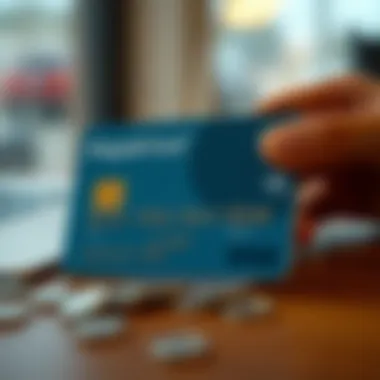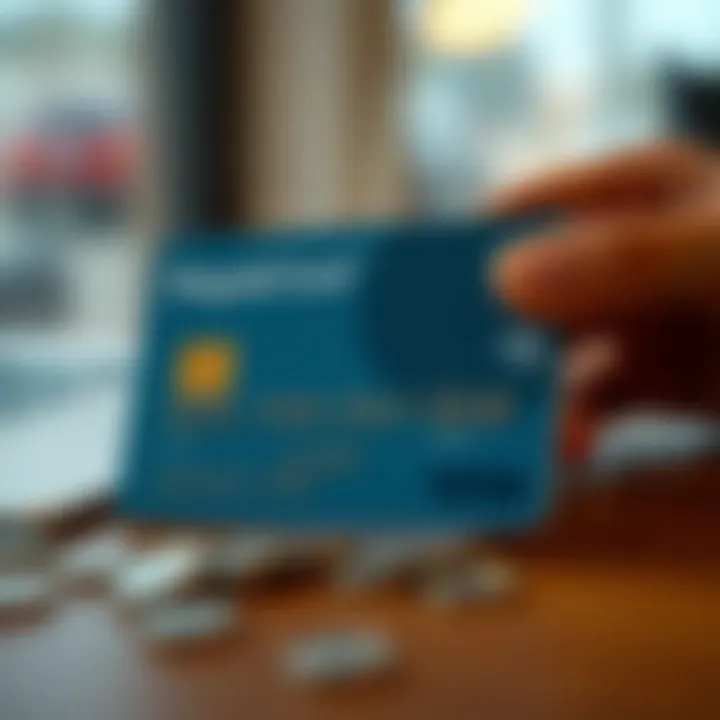Integrating Prepaid Cards into Bank Accounts: A Guide


Intro
Navigating the world of finances can feel like trying to catch smoke with your bare hands. Many people are on the lookout for ways to simplify their financial decisions while maximizing opportunities for both savings and spending. One relatively recent entrant into the financial landscape are prepaid cards. Combining these cards with traditional bank accounts brings a new layer of convenience and flexibility, though it’s not without its complexities. Understanding how to integrate prepaid cards into your bank account is essential for anyone looking to streamline their financial toolkit.
This guide will break down the various types of prepaid cards, discuss the integration process, and shed light on the pros and cons associated with this practice. The aim is to provide you with clear and actionable information. By the time you finish, you should have a solid grasp on how to maneuver through this financial territory.
Investment Terminology
When diving into any financial subject, familiarity with the terminology can really save you from stumbling blocks down the line. Here, we’ll outline some key terms relevant to prepaid cards and their integration into bank accounts.
Key Terms and Definitions
- Prepaid Card: A card that you load money onto in advance. Unlike credit cards, they do not allow for purchases beyond the amount loaded.
- Bank Account Integration: This refers to the process of linking your prepaid card directly to your bank account to facilitate transactions, balance transfers, or withdrawals.
- Load Fees: Costs incurred when adding money to a prepaid card. Knowing these can help avoid unexpected charges.
- Balance Inquiry: Checking how much money is left on a prepaid card. It’s crucial to know your balance to avoid overdraft or transaction declines.
- Debit Integration: Linking a prepaid card to your bank account in a manner similar to a debit card, meaning transactions withdraw directly from your bank funds.
Common Acronyms in Finance
- ATM: Automated Teller Machine, where cash can be withdrawn using your prepaid card.
- PIN: Personal Identification Number, a secure passcode used to authorize transactions.
- FDIC: Federal Deposit Insurance Corporation, insures the funds in your bank account but may not cover prepaid cards directly.
- APR: Annual Percentage Rate. Though not commonly applicable to prepaid cards, it’s good to know for overall financial literacy.
In embracing these terms, you lay a solid groundwork that will serve you as you journey into prepaid card integration.
Expert Insights
Whenever there’s a new financial avenue, experts are quick to weigh in. Below are insights tailored for beginners and seasoned investors alike, offering practical wisdom for effectively utilizing prepaid cards.
Investment Strategies Overview
Understanding your financial needs and habits can inform your strategy when integrating prepaid cards into your bank account. Many people find that using prepaid cards for travel or budgeting helps them manage their expenses better. For example, you may load a specific amount onto a prepaid card dedicated solely for travel expenses, ensuring you stick to your budget while away.
Tips from Financial Advisors
- Do Your Homework: Research the different types of prepaid cards before committing. Selection is key in finding a card that meets your specific needs.
- Keep an Eye on Fees: Not all prepaid cards are created equal, and some may hit you with sneaky fees that can eat into your balance.
- Establish a Routine: Regularly check the balance on your prepaid card and utilize it within your regular budgeting framework—consistency is important.
- Educate Yourself on Spending Habits: Examine your spending trends and determine where a prepaid card could add value and control, turning potential pitfalls into advantages.
"Understanding your tools is half the battle in mastering your finances."
In summation, integrating prepaid cards into bank accounts can create a mutually beneficial relationship that enhances financial management. Just like any investment, the more informed you are, the better decisions you can make. Stay tuned for more detailed strategies and a comprehensive step-by-step guide through the integration process.
Understanding Prepaid Cards
Prepaid cards have recently gained traction as flexible financial tools that blend the functionality of traditional banking with the convenience of modern payment solutions. As we explore how to merge prepaid cards with bank accounts, grasping the backbone of what these cards entail is crucial. They are not merely convenience items; they represent a paradigm shift in consumer finance, offering a workaround for individuals who may not fit neatly within conventional banking scenarios.
Definition and Functionality
A prepaid card is a payment card that can be loaded with a specific amount of money, which the holder can spend until the balance runs out. Unlike credit cards that allow users to borrow money from a bank’s credit line, prepaid cards draw directly from the user's set balance. This structure instills an inherent discipline in spending—once the money on the card is exhausted, further purchases are not possible unless additional funds are loaded.
These cards can be used wherever debit or credit cards are accepted, making them versatile choices for everyday spending. Furthermore, the functionality can vary, allowing users options such as online shopping, bill payments, and even cash withdrawals at ATMs, thereby catering to a variety of financial needs.
Types of Prepaid Cards
Diving deeper into the various forms of prepaid cards reveals a colorful tapestry of choices, each serving distinct purposes and user preferences.
General Purpose Reloadable Cards
General Purpose Reloadable Cards, often dubbed as GPR cards, are a popular choice for those looking to simplify their financial transactions. These cards can be reloaded multiple times, providing users with a semblance of a checking account without the need for a traditional bank. One major characteristic is that they can often be used worldwide wherever a payment network like Visa or Mastercard is accepted. The major benefit here is flexibility—consumers can manage their spending without falling into the trap of overspending.
However, users should be cautious about fees associated with these cards, which can include activation and reloading costs. A common drawback is their potential for incurring charges that might erode the value of convenience they offer.
Gifting and Travel Cards
Gifting and Travel Cards provide an innovative way to bless others without the reliability of cash. These prepaid cards come pre-loaded with funds, typically fixed amounts, making them a popular choice for gifts on special occasions. The significance here is that they can be tailored for use in different regions or for specific uses. For instance, a travel card could be loaded with the currency of the country one is visiting.
Their main advantage is that recipients are spared the awkwardness of returning unwanted gifts, receiving something practical instead. However, they can sometimes be subject to restrictions such as expiration dates or inability to reload, which could deter some consumers from utilizing them fully.
Payroll and Government Benefits Cards
Payroll and Government Benefits Cards represent a tailored solution for individuals receiving wages or social support in a secure manner. Rather than handling physical checks, which can be inconvenient and insecure, employers and government agencies now use these cards to distribute funds swiftly and securely.
The primary strength lies in their accessibility—the convenience of having funds loaded electronically reduces the burden of check cashing. Moreover, they often provide a user-friendly way for individuals to access their money immediately. Nevertheless, users face limitations in functionality and potential fees related to account management that could affect their overall experience.
Virtual Prepaid Cards
Virtual Prepaid Cards are emerging as a modern-day alternative appealing to tech-savvy consumers. Typically regarded as a safer way to shop online, these cards exist only in digital form. Users can generate a card number from a mobile app or a website, which can be used for online purchases without revealing sensitive banking information.
Their major selling point is security. Many individuals favor them to protect against fraud when making purchases. However, the inherent limitation is that they cannot be used for in-person transactions unless one transfers the balance to a physical card or uses the virtual one in specific compatible environments.
Advantages of Using Prepaid Cards


The advantages of leveraging prepaid cards within one's financial ecosystem are many.
Budget Control
For many individuals, budget control is not merely a concern but a crucial aspect of financial health. Prepaid cards allow users to set strict spending limits by loading only what they can afford. This characteristic serves as a safeguard against impulsive buys. By using prepaid cards, consumers have a tangible limit enforced by the card's balance, which can help curb overspending significantly.
While this may be seen as restrictive by some, the benefit of this control is positive reinforcement of saving habits. Users can create a stable financial environment for themselves, encouraging better money management.
Security Aspects
When it comes to security, prepaid cards offer a valuable option for safeguarding personal finances. Generally, the risk of overspending is mitigated, as once the money is gone from the card, that’s it. Unlike credit cards that can lead to uncontrollable debt, prepaid cards enable a stopgap against reckless behavior. They often carry lower fraud risks, especially in cases of theft, compared to traditional credit cards since they are not linked to personal bank accounts.
Although these cards aren't foolproof—they can still be subject to scams or fraudulent activities—the inherent design offers a layer of protection to users worried about data breaches or identity theft.
Accessibility for Unbanked Individuals
In an age where not everyone has access to traditional banking, prepaid cards serve a vital role by providing financial services to unbanked individuals. These cards can be acquired without prerequisites like credit checks or bank accounts, granting a pathway for individuals who often feel sidelined by conventional banking practices. This characteristic hugely benefits everyone, particularly those in low-income brackets.
While they free individuals from the constraints of traditional banks, the downside can be that some services may still end up costing more than expected due to hidden fees, which may affect the very expense savings they hope to achieve.
Connecting Prepaid Cards to Bank Accounts
Connecting prepaid cards to bank accounts provides a bridge between two essential financial tools, enhancing convenience and usability. This integration allows individuals to manage their finances more effectively, facilitating payments and budgeting in a more streamlined manner. From a practical standpoint, it allows users to transfer funds easily between their bank accounts and prepaid cards, making access to money seamless. Moreover, for those who encounter challenges with traditional banking, this link offers an alternative pathway for managing finances.
In essence, integrating prepaid cards into bank accounts can lead to better financial management and control. Users can keep track of spending, monitor transactions, and prevent overspending. Through exploring steps in this section, one will discover not just how to execute this process but also highlight the potential benefits and considerations involved.
Steps to Link a Prepaid Card
Gather Necessary Information
The first step in linking a prepaid card to a bank account is to gather relevant information. Knowing the exact details of the prepaid card – including the card number, expiration date, and security code – is crucial. This information ensures a smooth and hassle-free connection process. By being well-prepared with these details, you mitigate the risk of errors during the integration.
An important aspect of gathering this information is that it allows users to take control of their finances right from the start. Furthermore, this step lays a strong foundation for future transactions. A unique feature of this approach is the necessity of combining two forms of financial instruments.
Login to Your Bank Account
Once you have the necessary information, the following step is logging into the bank account. This act serves as a gateway to begin the linking process, ensuring that only authorized users can proceed. Security is paramount here, as you want to safeguard your bank account from unauthorized access.
The key characteristic of this step lies in its simplicity; banks design their platforms for ease of navigation. Yet, some users may find themselves struggling with the login process, especially if they struggle with remembering passwords or faced with two-factor authentication. This can sometimes lead to frustration.
Navigate to Financial Tools
After logging in, one must navigate to the financial tools section of the banking portal. This part is crucial as it contains the options for managing payment methods. Easily accessing this area can streamline the entire process of integrating prepaid cards.
Being familiar with the layout of your bank's digital offerings can make this step less daunting. The unique characteristic of these tools is that they provide a centralized hub for managing funds, thus allowing users to oversee all their financial activities in one place. However, if the tools are not intuitively designed, users may face difficulty finding the exact options needed to link their accounts.
Input Prepaid Card Details
The final step is to input the details of the prepaid card. This stage is where users effectively connect their prepaid card to their bank account. It's essential to double-check the information entered to avoid any future hurdles.
A unique feature of this step is that it often features safeguards, such as confirmation prompts or summary screens, which further minimize chances of error. While this is a beneficial aspect, it can also become tedious if too many confirmations are required. Properly inputting card details can open doors to extensive financial flexibility and smooth transaction experiences.
Common Platforms for Integration
Major Banking Institutions
Major banking institutions often have well-defined protocols for linking prepaid cards. Many utilize established procedures that are familiar to their customer base. By supporting this feature, these banks not only cater to consumer needs but also enhance competition in the market.
Having access to these services leads to convenience, but the major drawback can come in the form of varying transaction limits or fees, so it’s wise to review these details closely.
Online Banking Services
Online banking services represent the modern approach to managing finances. These platforms are typically user-friendly and designed to facilitate quick connections to prepaid cards. With higher efficiency, they contribute positively to the overall user experience.
Convenience is undoubtedly the standout characteristic here, allowing for integrations to happen in minutes. However, while they provide many perks, one must be cautious about the potential for phishing attempts that may compromise security.
Mobile Banking Applications
Mobile banking applications take the experience on-the-go, giving users the ability to link their prepaid cards directly from their smartphones. With features designed for ease of use, these apps appeal to a growing demographic seeking agility in financial management.
The flexibility of mobile banking is its major strength, empowering users to manage their funds anytime, anywhere. But high reliance on mobile apps can lead to challenges when app outages occur, as users may find themselves unable to access funds when needed.
Considerations When Adding a Prepaid Card
Integrating a prepaid card into your bank account can be a smart financial move. However, there are important considerations that come into play when deciding to do this. Understanding the nuances surrounding eligibility criteria and potential fees can help prevent any unwelcome surprises down the line. This section dissects the prerequisites and costs associated with using prepaid cards, ensuring you have a firm grasp on all factors before making the leap.


Eligibility Criteria
Account Type Requirements
Different banks have distinct policies for the types of accounts that can be linked with prepaid cards. Generally, checking and savings accounts serve as the most compatible options. These account types provide a solid foundation, as they typically allow for an easing of the process due to established protocols in most financial institutions.
A major characteristic here is that many traditional banks require at least one functional checking account before enabling the linking of a prepaid card. This requirement might seem like a hurdle, but it is designed to enhance security while managing funds effectively. One unique feature is the verification process involved, which can take several days; this is a common aspect of traditional banking operations and often reflects a broader effort to mitigate fraud.
While keeping these requirements in mind, it is beneficial to check if your bank has its own specific limitations; this awareness can facilitate a clearer navigation of the integration process.
Limitations by Prepaid Card Provider
Every prepaid card comes with its own set of rules and restrictions imposed by the issuing provider. These limitations can significantly impact how well a prepaid card functions when integrated with a bank account. For instance, some providers may restrict linking to certain bank accounts altogether, while others might only allow linked cards to be used domestically.
Customers often prefer providers with fewer limitations, as this flexibility fosters a more seamless experience. A key feature of these providers tends to be their customer service, which can vary widely. With limited support, users may struggle with common issues such as card balance inquiries or transaction disputes. It's essential to consider how these provider-specific constraints can align or conflict with your overall financial goals.
Potential Fees and Charges
When it comes to prepaid cards, hidden costs can often bite if you’re not paying attention. Awareness of fees can be the difference between a good deal and a headache. Let's explore some common fees associated with prepaid cards, which are critical to consider during integration with bank accounts.
Activation Fees
Some prepaid cards charge an activation fee when you first acquire them. This fee is typically one-time and varies from card to card. It exists mainly because providers often invest in the physical card production and activation processes. This fee serves to cover initial costs but can vary significantly among different providers, which necessitates comparison before commitment.
Activation fees can sometimes be avoided with promotional offers, so it pays to shop around. While they may seem minimal upfront, these costs can accumulate if you're consistently using new cards over time.
Monthly Maintenance Fees
Monthly maintenance fees are another consideration that can train your finances. While some prepaid cards don’t charge this, many do. These fees are generally applied to maintain the account or card and are charged on a repeated basis—often monthly.
The key factor here is whether the benefits of the card balance out this fee. For individuals who plan to use the card frequently for daily spending, it may be worth the cost. Conversely, for infrequent users, it could be seen as unnecessary unless specific features make the card indispensable.
Transaction Fees
Transaction fees are pertinent for every swipe, tap, or click you make with a prepaid card. Not all cards charge these, but those that do may apply fees for various types of transactions, including ATM withdrawals, point-of-sale transactions, or even online purchases. These fees can vary between providers, which places more emphasis on reviewing the terms of use beforehand.
Ultimately, understanding transaction fees can become a make-or-break factor depending on how you intend to use the card. For regular users, high fees on frequent transactions can lead to a financial strain, while someone with occasional use might find them considerably manageable.
In summary, before integrating a prepaid card into your banking system, scrutinizing eligibility criteria and fee structures should be at the forefront of your decision-making process. This diligence not only prepares you to handle the practicalities of integration but can also empower you with the knowledge to choose the best financial tools available.
Benefits of Integrating Prepaid Cards
Integrating prepaid cards into bank accounts opens the door to numerous financial benefits, making them an increasingly attractive option for many. This section sheds light on how they can simplify financial management, boost spending control, and offer greater convenience. Understanding these advantages helps individuals better manage their finances while leveraging the unique functionalities these cards provide.
Streamlined Financial Management
Combining Spending Sources
Combining spending sources into one financial management system can genuinely ease the chaos of managing multiple tools. A prepaid card that is linked to your bank account allows for a seamless blending of cash flow. Instead of juggling between different accounts and physical cash, users can keep everything under one roof, if you will.
This ability to combine spending provides clarity, as all transactions can be viewed in one central location. One key feature is that prepaid cards often come with online account management tools. This means you can easily track what you've spent in real time without having to piece together different account statements. Not only does this approach save time, but it can also minimize stress and confusion, allowing individuals to focus on what truly matters.
Pros of this method include enhanced visibility over your finances and reduced risk of missing bills or additional fees. On the downside, some may find a learning curve associated with transitioning to digital management, but many agree it’s worth the initial effort.
Enhanced Tracking of Expenses
Tracking expenses can often feel like herding cats; it’s a task many avoid. However, with the integration of prepaid cards, the chore transforms into a manageable routine. Prepaid cards can give you immediate insights into where your money is really going, with every purchase automatically logged and categorized in digital platforms.
One major advantage is the ease of accessing transaction histories through a user-friendly app or website. This level of transparency not only promotes accountability but also encourages informed decision-making about future spending. The unique feature here is that many prepaid cards offer automatic budgeting tools that analyze past spending habits, helping individuals develop better financial habits.
However, not all prepaid cards come with this extensive tracking functionality. Some might offer minimal tracking, leaving users to do their own heavy lifting. Still, those that do provide robust tracking can significantly improve overall financial health.
Increased Spending Control
Preventing Overspending
When it comes to avoiding overspending, prepaid cards can be a lifesaver. Since these cards are not linked to traditional credit but rather to actual funds, they inherently limit how much one can spend. This characteristic makes them ideal for individuals looking to curb impulsive buying tendencies.
The built-in restrictions of prepaid cards foster a mentality of limited availability that can bolster responsible spending. People using these cards often report feeling a stronger sense of control over their finances. While cash can sometimes be lost or forgotten about, prepaid cards ensure that every dollar is accounted for.
However, while they provide a useful constraint, some may find themselves in a bind if unexpected expenses arise and there are insufficient funds loaded onto the card. Recognizing this potential pitfall beforehand can make all the difference.
Setting Spending Limits
Setting spending limits is another tool in the financial toolbox that can greatly enhance spending control. Many prepaid card providers allow users to set daily, weekly, or monthly limits on their spending, creating an additional layer of protection against overspending. This is particularly advantageous for families who want to manage children's spending, or individuals hoping to stick to strict budgets.


The key characteristic of this feature is flexibility; users can adjust limits as their financial situation changes, making it adaptable to various life stages or circumstances. Prepaid cards that offer this option often come with accompanying apps that send alerts when users get close to their limits, which allows for real-time adjustments and informed choices.
However, setting limits can hinder spending in situations where flexibility may be necessary, like last-minute purchases. Thus, while it promotes discipline, users should be cautious about letting financial rigidity detract from spontaneous yet responsible spending in life.
In summary, integrating prepaid cards into bank accounts brings about substantial benefits in terms of financial management and spending control. Users should weigh these advantages against potential limitations, but the added clarity and control can undoubtedly contribute to improved financial health.
Challenges and Limitations
Navigating the integration of prepaid cards with bank accounts presents a host of challenges and limitations that consumers should carefully consider. While the benefits can be significant, understanding these obstacles is essential for effective financial management. From transaction constraints to customer service hurdles, this section will break down the specific issues that may arise, helping you to fully grasp the landscape of prepaid card usage.
Restrictions on Usage
Limited Acceptance
Limited acceptance of prepaid cards is a critical factor to explore. Not all merchants and service providers have embraced this payment method, leading to situations where your card might not fulfill its intended purpose. For example, some gas stations or small retailers may not accept certain prepaid brands. This reality can be frustrating for users who expect ubiquitous access, especially in times when convenience is heightened in commerce.
The key characteristic of this limitation lies in its varied acceptance across different sectors. While large chains like Walmart andShell have broad acceptance, local businesses might not have the systems in place to process such cards. This aspect makes understanding where and how your card can be used necessary to avoid any hiccups during transactions. In this article, we can emphasize that being mindful of these limitations could potentially save you from unnecessary embarrassment at the counter.
Besides this, some prepaid cards contain features tailored for specific retail ecosystems. An advantage of this structure is that it may come with promotions or savings for certain types of purchases. However, the downside is applicable restrictions which might complicate a user's ability to shop freely across various platforms.
Online Shopping Restrictions
Another significant hurdle involves online shopping restrictions. While many prepaid cards allow for online purchases, some might hit roadblocks when it comes to larger transactions or recurring payments. This means if you’re looking to buy a subscription service or pay for a high-price item online, you might find yourself with a surprise decline notice.
The defining feature of online shopping restrictions rests in how card issuers govern transaction limits and merchant types. Unlike debit or credit cards, which are widely accepted, prepaid cards might face limitations with certain online platforms. For instance, while sites like Amazon accept prepaid cards, others may not support this method, causing a snag in your purchasing journey. This feature directly impacts your overall purchasing experience.
Consumers might find themselves aligning with a specific card issuer who provides better access for online transactions, enhancing the benefits of using prepaid options. Yet, the restrictions are often frustrating, as buyers plan to use their funds only to discover they can't process a transaction. Hence, awareness about these constraints helps in making informed decisions when utilizing prepaid cards.
Customer Service Issues
Difficulty in Dispute Resolution
When it comes to customer service, prepaid card users frequently encounter difficulty in dispute resolution. Unlike traditional bank accounts or credit cards, where you may have a dedicated point of contact, the process of resolving disputable transactions can be more convoluted with prepaid cards.
This aspect presents a dual challenge: first, getting through to customer service can be a trial in itself, and once you manage to reach them, the protocols for handling disputes may lack comprehensive support. Consequently, this can lead to frustrations especially during periods when rapid resolution is necessary, such as in fraud cases.
A potential drawback of this process is that issues often go unresolved for weeks. This unpredictability can bring about significant stress, particularly when you desperately need prompt assistance. Complaints about unfavorable experiences in resolving disputes suggests a need for consumers to read the fine print and understand the limitations of support associated with different prepaid cards.
Variable Support From Providers
Finally, an important consideration involves variable support from providers. Not all prepaid card companies offer the same level of service, which may result in disparities in customer support experience. Some issuers may have robust helplines and provide prompt assistance, while others might leave customers waiting or navigating FAQs.
The key feature of this variability is the inconsistent quality of service, which can vary widely based on the issuer's size and resources. Smaller or newer companies might struggle with managing customer inquiries compared to established brands. As a result, users could find themselves stuck between a rock and a hard place when needing assistance.
This variability poses risks, as problems might not get solved in a timely manner, leading to customer dissatisfaction. Engaging with a reputable prepaid card issuer that demonstrates a commitment to customer service could be a beneficial strategy, lest you find yourself left in the lurch.
Future Trends in Prepaid Cards
As we navigate the ever-evolving landscape of financial services, prepaid cards are making their mark in a significant way. Integrating them with bank accounts is becoming more streamlined, reflecting the broader shifts in how consumers manage their finances. Understanding these trends is crucial, particularly as the financial world embraces innovation and technology. Today, we’re seeing an increase in the usage of digital wallets and advanced payment technology.
Emergence of Digital Wallets
Integration with Prepaid Options
Digital wallets are changing the game when it comes to managing prepaid cards. These wallets allow users not only to store their card information but also to access a range of financial services all in one place. The integration with prepaid options enhances flexibility, enabling smoother transactions and improved financial oversight. One key characteristic of this integration is the convenience it offers. With just a few taps on a smartphone, users can access funds stored on their prepaid cards, making purchases or transferring money.
The unique feature of digital wallets lies in their capability to link multiple prepaid cards, giving users a comprehensive overview of their finances at a glance. This aspect is particularly beneficial for those who juggle multiple cards, as it simplifies tracking and managing various sources of funds.
However, challenges may arise such as compatibility issues between the wallet and certain prepaid cards. Users must ensure that their prepaid card is accepted by their chosen digital wallet platform, which can sometimes limit access to funds.
Enhanced User Experience
The enhanced user experience with digital wallets is another notable trend. By focusing on user-centered design, these platforms aim to provide a more intuitive interface for users. This characteristic has made digital wallets a popular choice, as it allows even less tech-savvy individuals to navigate the app with ease.
A unique feature of this user experience is the ability to customize notifications and transaction alerts. Users can receive real-time updates about spending, helping them stay within budget and avoid overspending. While this personalization can lead to better financial management, some users may find the sheer volume of notifications overwhelming.
Innovations in Payment Technology
Contactless Payments
Contactless payments are fundamentally transforming how transactions are made. This technology allows users to simply wave their prepaid card or smartphone in front of a reader to complete a purchase, making it increasingly convenient. The key characteristic of contactless payments is speed; transactions can be completed in seconds, enhancing efficiency and reducing queues at checkout.
One unique aspect of this payment method is its hygienic nature, highlighted during the pandemic when many consumers preferred touch-free options. Although widely accepted, not all merchants have adopted this technology yet, creating barriers for some users.
Blockchain and Cryptocurrency Adoption
Blockchain technology and cryptocurrency are emerging forces in the prepaid card space. The integration of these innovations seeks to enhance security and transparency in financial transactions. One notable characteristic of blockchain is its decentralization, which reduces the risk of fraud. This feature makes prepaid cards linked to cryptocurrencies appealing for tech-savvy users looking to diversify their financial tools.
However, the volatile nature of cryptocurrency can be a double-edged sword. While it offers the potential for significant gains, users must be aware of the risks associated with fluctuating values. Additionally, regulatory uncertainties surrounding cryptocurrency can affect how it interacts with traditional prepaid card systems.
As digital wallets grow in popularity and payment technologies advance, understanding these trends is essential for consumers looking to harness the full potential of prepaid cards.















